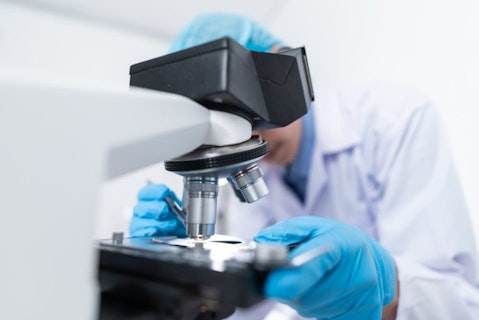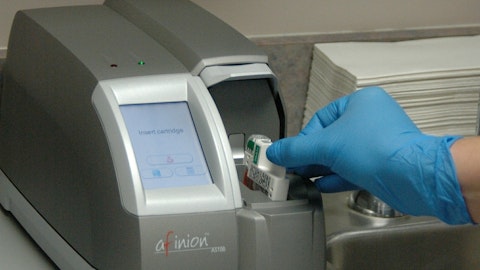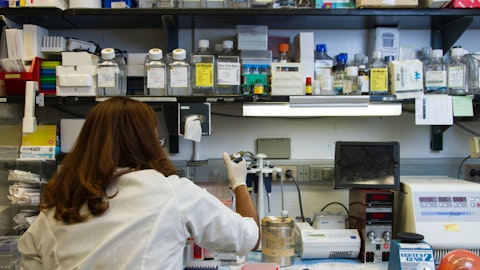Novo Nordisk A/S (NYSE:NVO) Q1 2023 Earnings Call Transcript May 4, 2023
Operator: Good day, and thank you for standing by. Welcome to the First Quarter 2023 Novo Nordisk A/S Earnings Conference Call. . Please be advised that this conference is being recorded. I would now like to hand the conference over to your speaker today, CEO, Lars Fruergaard Jorgensen. Please go ahead.
Lars Fruergaard Jorgensen: Thank you, operator. Welcome to this Novo Nordisk earnings call for the first three months of 2023. Today’s announcement discloses the full set of results, following the release of top-line results and updated outlook earlier in April. This was shared ahead of time due to Danish securities regulations. My name is Lars Fruergaard Jorgensen, and I’m the CEO of Novo Nordisk. With me today, I have Executive Vice President and Head of Commercial Strategy and Corporate Affairs, Camilla Sylvest; Executive Vice President and Head of North America Operations, Doug Langa; Executive Vice President and Head of Development, Martin Holst Lange; and finally, Chief Financial Officer, Karsten Munk Knudsen. All of us will be available for the Q&A session.
Today’s announcement and the slides for this call are available on our website, novonordisk.com. Please note that this call is being webcasted live, and a recording will be made available on our website as well. The call is scheduled to last one hour. Please turn to the next slide. The presentation is structured as outlined on Slide 2. Please note that all sales and operating profit growth statements will be at constant exchange rate unless otherwise specified. As always, I need to advise you that this call will contain forward-looking statements such as subject to risks and uncertainty that could cause actual results to differ materially from expectations. For further information on the risk factors, please see the company announcement for the first three months of 2023 and the slides prepared for this presentation.
Please turn to the next slide. In the first three months of 2023, we delivered 25% sales growth and 28% operating profit growth. Furthermore, we raised the outlook for the year in the early announcement shared on April 30, 2023 — 13th of 2033. I’d like to start this call by going through the performance highlights across our strategic aspirations before handing over the word to my colleagues. Within purpose and sustainability, we continue to make progress across all dimensions. Our carbon emissions decreased by 21% compared to pre-pandemic levels in 2019. In line with our strategic aspirations of being a sustainable employer, we continue to expand the number of women in senior leadership positions. This is now 39% compared to 37% end of March 2022.
Within R&D, we are pleased with the successful completion of PIONEER PLUS trial with oral semaglutide 25 and 50 milligram that is setting the bar for all incretins in Type 2 diabetes. Martin will come back to this and our overall R&D milestones later. Within rare endocrine disorders, we are happy to announce the once-weekly Sogroya was approved by the U.S. FDA for the treatment of children with growth hormone deficiency. This is an important milestone for patients and for the rare disease portfolio. Quarterly sales growth reflects solid commercial execution across operating units. Both operating units contributed to sales growth driven by demand for our GLP-1 treatments for both diabetes and obesity. In the U.S., the prescription trends for Wegovy highlights the high unmet need for people living with obesity.
Camilla and Doug will go through the details per therapy area later. Karsten will go through the financials, but I’m very pleased with the performance so far this year. With that, I’ll give the word to Camilla for an update on execution.
Camilla Sylvest: Thank you, Lars, and please turn to the next slide. As Lars mentioned, our total sales increased by 25% in the first three months of 2023. This sales increase was driven by both operating units, with North America Operations growing by 41% and international operations growing 10%. Sales growth was positively impacted by U.S. wholesaler inventory movements. Our GLP-1 sales increased 50%, driven by North America growing 50% and international operations growing 52%. Insulin sales decreased by 11%, driven by an 8% decline in international operations and an 18% sales decline in North America operations. Insulin sales in international operations were impacted by the implementation of volume-based procurement in China in May 2022.
Obesity care sales grew 124% overall. In international operations, sales grew 65%, driven by both Saxenda and Wegovy. In North America operations, obesity care sales grew 156%. Total rare disease sales decreased by 16%, driven by a 17% decrease in international operations and by a 14% decrease in North America operations, where endocrine disorder sales were unfortunately impacted by a temporary reduction in manufacturing output. Please turn to the next slide. With 21% sales growth in our diabetes care, we are growing faster than the total diabetes market, leading to an increased market share of 32.2%. With this, we are on track to reach one-third of the diabetes value market by 2025. This increase primarily reflects GLP-1 market growth as well as share gains in both operating units.
Please turn to the next slide. In international operations, total diabetes care sales increased by 12% in the first 3 months of 2023, driven by GLP-1 sales growing 52%. Novo Nordisk is the market leader in international operations with a GLP-1 value market share of 65%, driven by all geographies. Ozempic continues its GLP-1 market leadership with around 44% market share. We are also pleased to see Rybelsus increasing its market share to just shy of 9%, driven by a strong uptake across geographies. And with that, I will hand over the word to Doug.
Doug Langa: Thank you for that update, Camilla. Please turn to the next slide. At around 60% volume growth in Q1 of 2023, the U.S. GLP-1 market continued to accelerate. This acceleration is driven by all-time high levels of new patients starting on our portfolio of GLP-1 products. Measured on total prescriptions, Novo Nordisk has expanded its market leadership position with a current market share of around 53%. Please go to the next slide. Obesity care sales increased by 124%, with 156% growth in North America operations and 65% growth in international operations. The global brand of obesity market expansion continues with a global volume growth of 54%. In international operations, we are encouraged by the continued performance of Saxenda and that the Wegovy launches in Denmark and Norway are both progressing very well.
In the U.S., obesity care sales grew by 162%, with both Wegovy and Saxenda contributing to the growth. Since the Wegovy commercial relaunch in January of 2023, the prescription trends have highlighted the high unmet need for safe and efficacious products to help people living with obesity. We continue to scale supply capacity. And the second CMO for Wegovy is now producing to the market, providing additional capacity and risk mitigation. However, to safeguard continuity of care, the supply of the lower Wegovy dose strengths in the U.S. will be reduced temporarily. Next slide, please. Our rare disease sales decreased by 16%, driven by a 17% sales decrease in international operations and by a 14% decrease in North America operations. Rare blood disorder sales decreased by 3%, driven by NovoSeven, and partially offset by the launch of products in hemophilia A and B.
Specifically, hemophilia A sales grew by 19%, hemophilia B by 15%, and NovoSeven decreased by 11%. Rare endocrine disorder sales declined by 38%, reflecting a temporary reduction in manufacturing output and lower realized prices in the U.S. Now over to you, Martin, for an update on R&D.

Martin Lange: Thank you, Doug. Please turn to Slide 11. In March, we announced the exciting headline results from the PIONEER PLUS phase 3b trial with once-daily oral semaglutide 25 and 50 milligram, respectively. PIONEER PLUS was a blinded 68-week trial comparing once-daily oral semaglutide 25 and 50 milligram to that of 14 milligram. The objective of the trial was to assess the efficacy and safety of semaglutide, 25 and 50 milligram as an add-on to stable doses of one to three oral antidiabetic medicines in approximately 1,600 people with Type 2 diabetes in need of treatment intensification. The trial achieved its primary endpoint by demonstrating a superior reduction in A1c at week 52 with both doses as compared to 14 milligram.
Here, we present the trial product estimands for A1c and weight loss. From a baseline of A1c of 9%, people treated with 25 and 50 milligram achieved statistically significant A1c reductions of 1.9 and 2.2 percentage points, respectively, compared with 1.5 percentage points with 14 milligram. People in the trial had a mean baseline body weight of 96.4 kilograms. People receiving 25 and 50 milligram of semaglutide experienced a statistically significantly higher weight loss of 7 and 9.2 kilograms, respectively, compared with a reduction of 4.5 kilograms with 14 milligram. In the trial, all doses of oral semaglutide appear to have a safe and well-tolerated profile. The most common adverse events were gastrointestinal and were consistent with the GLP-1 receptor agonist class.
GI events were most prominent during dose escalation and more frequent with oral semaglutide 25 and 50 milligram then with oral semaglutide 14 milligram. To sum up, we are very pleased with the results from the PIONEER PLUS trial that will provide people with Type 2 diabetes with further dose escalation options if additional glycemic control or weight loss is required. We expect to file for regulatory approval in the U.S. and EU during 2023. Given the impressive growth that we are seeing across semaglutide brands, the global rollout of the 25- and 50-milligram doses is contingent on portfolio prioritizations and manufacturing capacity. Next slide, please. Turning to broader R&D milestones. I would like to highlight some of the other exciting events, trial readouts, and initiations across our therapy areas during the course of 2023.
Within diabetes, I’m happy to share that we have submitted once-weekly insulin icodec for regulatory approval in the EU, U.S., and China for the treatment of both Type 1 and Type 2 diabetes. We have also completed a Phase 2 trial with a fixed dose combination of subcutaneous semaglutide and a once-weekly GIP analog. The fixed-dose combination did not show superior A1C reductions or weight loss compared to semaglutide 2.4 milligram. Following the completion of the trial, we have terminated further development of this program. In relation to this, we have successfully completed a phase 1 trial with a GLP-1/GIP co-agonist. In the trial, the co-agonist appears safe and well tolerated. And based on the results, we now plan to initiate a Phase 2 trial with a subcutaneous formulation in pursuit of further innovation within the GLP-1 space.
In April, we initiated the REDEFINE 3 trial, a cardiovascular outcome study with the objective to confirm cardiovascular safety of CagriSema compared to placebo in addition to standard of care. Furthermore, we plan to initiate REDEFINE 2 in Type 2 diabetes patients with obesity in the second half of 2023. Within obesity, we have many exciting phase 3 trials and readouts during 2023, including the cardiovascular outcomes trials: STEP, HFpEF, and SELECT with Wegovy. Both trials are designed to look beyond weight loss and focus on obesity-associated comorbidities. We believe that reducing the risk of obesity-associated comorbidities will not only make a big difference for the individual patients, but also add broader value to society. Later this quarter, we are also looking forward to the readout of the OASIS 1 trial with oral semaglutide, 50 milligram.
This will be the first GLP-1 in a tablet for the treatment of obesity. With regard to concizumab for the treatment of hemophilia A and B with inhibitors, we received a complete response letter from the FDA. In the letter, the FDA requested additional information related to the monitoring and dosing of patients to ensure that concizumab is administered as intended. Further information on the manufacturing process was also requested. We will work now closely with the FDA to provide the requested data. And importantly, concizumab was earlier this quarter approved in Canada. In rare endocrine disorders, we are pleased that Sogroya, the long-acting growth hormone somapacitan, was approved by the U.S. FDA for the treatment of children with growth hormone deficiency, 2.5 years of age and older.
Lastly, within other serious chronic diseases, we are excited to share that we have now initiated two cell-based therapy treatments in advanced heart failure and Parkinson’s disease, respectively. This reflects our commitment to continuously mature our technology platforms that are essential to drive innovation across the diseases that we target. With that, over to you, Karsten.
Karsten Munk Knudsen: Thank you, Martin. Please turn to the next slide. In the first three months of 2023, our sales grew by 27% in Danish kroner and 25% at constant exchange rates, driven by both our operating units. The gross margin increased to 84.7% compared to 83.5% in 2022. The increase is driven by a positive product mix, reflecting increased sales of GLP-1-based treatments and a positive currency impact. This is partially countered by costs related to the ongoing capacity expansions as well as lower realized prices, mainly in the U.S. and China. Sales and distribution costs increased by 22% in Danish kroner and by 20% at constant exchange rates. The increase is driven by both operating units. In North America operations, the cost increase is driven by the relaunch of Wegovy and promotional activities for Ozempic.
In international operations, the cost increase is driven by promotional activities for Rybelsus and Ozempic, as well as obesity care market development activities. Research and development costs increased by 29% measured in Danish kroner and 28% at constant exchange rates. The increase is driven by higher late-stage clinical trial activity and increased early research activities compared to the first quarter of 2022. The acquisition of Forma Therapeutics in 2022 also impacted R&D spend. Administration costs increased by 10% measured in Danish kroner and by 9% at constant exchange rates. Operating profit increased by 31% measured in Danish kroner and by 28% at constant exchange rates, reflecting the sales growth. Net financial items showed a net loss of DKK 0.3 billion compared to a net loss of around DKK 1.2 billion in 2022.
This primarily reflects losses on nonhedged currencies. As per the end of March ’23, a positive market value of financial contracts of approximately DKK 2.2 billion has been deferred for recognition in 2023. The effective tax rate in the first three months of 2023 was 19.9% compared to an effective tax rate of 20.7% in 2022. Net profit increased by 39%, and diluted earnings per share increased by 41% to DKK 8.78. Free cash flow was at DKK 24.8 billion compared to DKK 21.6 billion in 2022, supporting the strategic aspiration to deliver attractive capital allocation to shareholders. The cash conversion is positively impacted by timing of payment of rebates in the U.S. This includes provisions related to the revised 340B distribution policy in the U.S. Please note that income under the 340B program has been partially recognized.
Capital expenditure for property, plant, and equipment was DKK 4.7 billion compared to DKK 1.5 billion in 2022. This reflects investments in additional capacity for active pharmaceutical ingredient production and fill/finish capacity for both current and future injectable and oral products. Please go to the next slide. We entered 2023 with a solid growth momentum. And following the acceleration seen in the first quarter, we expect sales growth to be between to 24% and 30% at constant exchange rates. This is based on a number of assumptions as described in the company announcement. The guidance reflects expectations for sales growth in both operating units and mainly driven by volume growth of GLP-1-based treatments for diabetes and obesity care.
This is partially countered by declining sales in rare disease due to a temporary reduction in manufacturing output. The guidance ranges for sales and operating profit reflect the level of volume growth of GLP-1-based diabetes treatments. It also reflects the inherent uncertainty of the pace of obesity care market expansion, following the relaunch of Wegovy in the U.S. and gradual rollout in international operations. The outlook includes an expectation of continued periodic supply constraints and the related drug shortage notifications in 2023 across a number of products and geographies. This is driven by higher-than-expected volume growth for GLP-1-based products, such as Ozempic and Wegovy and temporary capacity limitations at some manufacturing sites.
We are continuing to increase our supply capacity. We expect that operating profit will grow between 28% and 34% at constant exchange rates. This primarily reflects the sales growth outlook and continued investments in future and current growth drivers within research, development, and commercial. In R&D, we continue to invest to progress the mid- and late-stage pipeline while expanding and progressing our preclinical project portfolio. The step-up in commercial investments are mainly allocated to the relaunch of Wegovy in the U.S., obesity care market development activities in international operations, as well as promotional activities for Ozempic and Rybelsus. For 2023, we expect net financial items to amount to a gain of around DKK 3 billion, mainly reflecting gains associated with foreign exchange hedging contracts.
Capital expenditure is still expected to be around DKK 25 billion, reflecting investments in additional capacity for active pharmaceutical ingredients and fill/finish capacity for both current and future injectable and oral products. Our free cash flow is now expected to be between DKK 66 million and DKK 78 billion, reflecting the sales growth and investments in capital expenditures. Based on the increased expectations for cash flow generation, the board of directors has approved an expansion of the 2023 share repurchase program by DKK 2 billion to DKK 30 billion in total. That caused the outlook for 2023. Now back to you, Lars, for final remarks.
Lars Fruergaard Jorgensen: Thank you, Karsten. Please turn to the final slide. We’re very pleased with the double-digit sales growth for the first three months of 2023. Sales growth was driven by both international operations as well as North America operations. While both operating units contributed to sales growth, the Wegovy relaunch has accelerated sales growth in North America. In general, the sales growth was driven by a continued strong demand for our portfolio of GLP-1 treatment for diabetes and obesity care. The commercial relaunch of Wegovy in the U.S. has underlined the high unmet need for efficacious and safe treatments for people living with obesity and value to society. We’re very pleased with the readout of the PIONEER PLUS trial, which has established a new efficacy standard for all diabetes treatments.
These results have made us optimistic ahead of the OASIS 1 results, covering oral semaglutide in obesity. Overall, we look forward to sharing results from several exciting trials reading out in 2023. With that, we’re now ready for the Q&A, while I kindly ask all participants to limit her or himself to one or maximum two questions. Operator, we’re now ready to take the first question.
See also 12 Most Profitable Gold Stocks and 16 Best Places to Live in Texas.
Q&A Session
Follow Novo Nordisk A S (NYSE:NVO)
Follow Novo Nordisk A S (NYSE:NVO)
Operator: . And now we’re going to take our first question, and the question comes from the line of Peter Verdult from Citi. Your line is open. Please ask your question.
Pete Verdult: Thank you. I’m Pete of Citi. Just two quick ones for Karsten. Firstly, just the top end of the updated revenue guidance that you provided last month. Should we, as the market, view that as the best Novo can achieve this year in light of your projected supply capacities? Or is there still potential outside of the table? And then secondly, Karsten, just what are your latest thoughts on how GLP-1 pricing dynamics between diabetes and obesity changes with the arrival of competition later this year? Does that differential price point you enjoy hold? Or does your guidance assume the GLP-1 pricing quickly coming down? Just any updated thoughts there would be helpful.
Lars Fruergaard Jorgensen: So thank you, Pete. So first, Karsten on the top end guidance. And then on GLP-1 pricing, I don’t know, Camilla, if you have a perspective of that.
Karsten Munk Knudsen: Yes. Hi, Pete, and thanks for that set of questions. So as a starting point, delivering and guiding between 24% and 30% sales growth, it’s just important to remember, as a starting point, this is really a historic level of sales growth for Novo Nordisk on a sizable base in the first place. And then to your question, is 30% the max, of course, in terms of supply capacity, we can supply to the entire guidance range. So that is our starting point. And as I said at the last quarter, the previous ceiling there was not a magic ceiling. What I will say at this point in time is that we’re getting closer to a ceiling, but 30% is not a hard ceiling, if I can put it that way. And to put a little bit of color to that comment, then I would say when I look at our current supply/demand balance for our product portfolio, then we do have drug shortage notifications in a number of markets on our GLP-1 portfolio ex-U.S. currently.
And as we’re covering in today’s release, then we are reducing the low-dose strengths of Wegovy. So just indicating that we are running closer to max capacity in terms of what we can supply to the market in a sustainable fashion.
Camilla Sylvest: Thank you. And on the diabetes pricing dynamics, we have previously discussed that, of course, there are, on a yearly basis, adjustment to the pricing also in GLP-1 based on the volume dynamics. But overall, we expect a stable, competitive environment, and that basically means that these are the adjustments that we expect. Then worthwhile reminding that the GLP-1 class as such is very underexploited both in North America but also in international operations. So in North America, it’s around 10% of the diabetes market. And in the rest of the world, including the U.S., it’s 5%. So there is still potential for more people being supported by GLP-1 treatment.
Lars Fruergaard Jorgensen: Thank you, Karsten. Thank you, Camilla. And thank you, Pete. Next question please.
Operator: Now we’re going to take our next question, and the next question comes from the line of Michael Nedelcovych from TD Cowen. Your line is open. Please ask your question.
Michael Nedelcovych: Thank you. Although there have been some supply gaps, Wegovy has been in the market now for nearly 2 years in the U.S. Do you have a sense yet of what median treatment duration is starting to look like in real-world practice? Should we be thinking along the lines of one year, two years, maybe longer? And then on the GIP/GLP, could you provide any detail on this agent? It sounds like it’s a single/dual-agonist molecule, and it’s moving in ahead in the subcutaneous formulation. Is the oral formulation still going to be developed after the subcutaneous? And more broadly on the mechanism, Novo has suggested in the past that it’s unclear what contribution GIP be making to weight loss. Have you become more convinced of this mechanism? Or are you simply being thorough? Thank you.
Lars Fruergaard Jorgensen: Thank you, Michael. So if I start on duration of Wegovy, then Martin can try to explain about our innovation. So it’s still early, too early to comment much about duration. If you look at our very, very impressive uptake in terms of number of scripts, total scripts, if there was a significant dropout, I don’t think you would be seeing that trend curve. So we’re very encouraged by that. You can also see when we look at the individual dose strengths that there is a close to perfect titration of patients who start on the low dose. After some time, you titrate up. And patients are still titrating up on the high dose. So if you had asked me to draw that before launch, I would have brought something that looked like that for a good day.
So very, very encouraging, say, response from patients and how they move up the doses and how that drives total scripts. So we still need a longer time to assess what the safe time would be. So I think that’s actually a very positive sign. And Martin, on GIP/GLP?
Martin Lange: Yes, absolutely. So very briefly, maybe take a step back. So we had two programs running. One was a co-formulation of semaglutide and GIP that we had in Phase 2, and that was the one I described where we actually did not see any effect of adding GIP to semaglutide on either placebo control nor wheelers. That would indicate that the role of GIP, at least in effect of dose combination setting, is minimal. We then had another track, which is a co-agonist or a unimolecular format. This, we ran in phase 1. And we saw, as I said, results that would encourage us to progress this into Phase 2. When we then discussed the role of GIP, I don’t think we’ve become 100% wiser. Our dose combination or fixed-dose combination study would suggest no role of GIP, but we also have to acknowledge that in the unimolecular formats.
We see a good efficacy, and this could then be actually a really good activation of the GLP-1 system or maybe a discrete added benefit of auto-targeting the GIP receptor. I think the jury is still out. And for now, we’re just encouraged by the clinical data that draws us to go into Phase 2 with this asset.
Lars Fruergaard Jorgensen: And then to add, you should really see it as a leadership aeration by Novo Nordisk that we wanna have a really strong portfolio in this space. So we are turning every stone. And I think we have exciting science in both the GLP-1 space, amylin space, GIP space, and potentially others, and we’re looking at how we can maximize that for the benefit of patients. Thank you, Martin. And thank you, Michael. So next question please.




